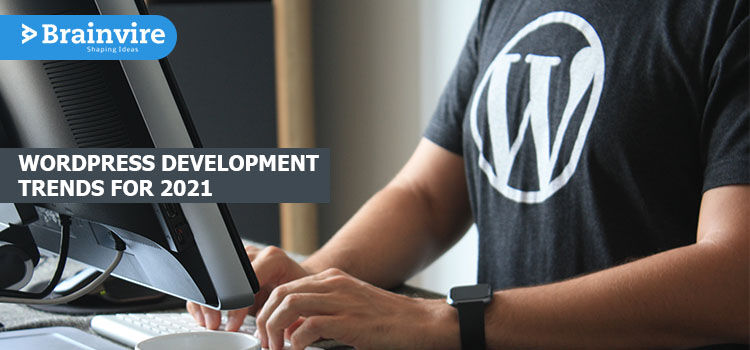
Website development is an ongoing and dynamic domain that keeps transforming every time a new technology emerges.
In this article, we have mentioned different web development trends that you need to always look out for. Here is a gist of all the latest technologies that we will be talking about:
? Progressive Website Applications (PWAs)
? Chatbots
? WebAssembly
? Voice Search
? Single Page Applications (SPAs)
? Motion User Interface (UI)
? Accelerated Mobile Pages (AMP
Before we look at the emerging and existing trends, let’s understand what is in store for small businesses in 2021 –
In 2021, the web development field is likely to witness a deluge of trendsetting possibilities. The website developers will also join the bandwagon by adopting the emerging technologies, experimenting with the upcoming techniques, and reinventing the existing ones. However, certain trends are here to stay and go beyond 2021.
So for small businesses to gain that competitive edge, it’s vital to watch out for these technologies and implement them as soon as possible.
In order to develop products in line with the latest trends, you need to hire website designers and developers who always stay on top of the emerging technologies and trends.
Now that we know what small businesses can expect, let’s dive straight into the top website development trends.
Trend #1 – Progressive Website Applications (PWAs)
PWA is basically a web application that leverages state of the art website capabilities to offer an experience similar to an app. In simple words, it is fully equipped with the potential of both mobile and website apps.
Professionals suggest that PWAs are highly receptive, safe, re-engageable, linkable, and connectivity-independent, which currently makes them the biggest trend amid mobile users.
Pinterest would be the best example, as it witnessed an increase of 50% in its clickthrough rates and 60% in its core engagements after transitioning to PWA.
Trend #2 – Chatbots
Chatbots are nothing but software processing and simulating human-like conversations with visitors. However, it can either be a program that resolves customer queries or an intricate software that offers a personalized customer experience.
Simply put, it enables you to easily communicate with websites, devices, and applications. In order to offer a response to a visitor’s request, a chatbot uses Artificial Intelligence (AI), Machine Learning (ML), and Natural Language Processing (NLP). This way it not only answers as many queries as possible but also helps a business to lower overhead expenses while improving its efficiency.
Gartner suggests that, by the end of 2021, AI will be leveraged to manage nearly 15% of global online customer interaction. Also by 2022, around 70% of white-collar experts will be engaging with conversational channels on a daily basis.
Trend #3 – WebAssembly
Also known as Wasm, WebAssembly is curated by the W3C (World Wide Web Consortium) to allow high performing apps to function smoothly on a website. It’s specifically designed for high-level programming languages.
With WebAssembly, web developers can easily compile any programming language’s code into bytecode, which is present in every browser.
By leveraging this technology, you can achieve the following benefits:
Quickly implements the code
- Offers top-notch security
- Independent of platform and programming languages
- Independent of tools
When it comes to Wasm, its speed, small footprint, and cross-platform scripting play a huge role. This is because these three elements are crucial in today’s website/eCommerce development.
Trend #4 – Voice Search
Voice search, also known as voice-enabled, is an incredible technology that enables you to use your voice to search for things on the Internet. It is in contrast to the normal search method of typing in the search box and clicking on the enter option.
This is one such technology that leverages a speech recognition software that accurately understands your words to deliver relevant search results. A few examples of this technology include Amazon’s Alexa, Microsoft’s Cortana, Apple’s Siri, and Google Assistant.
With this technology, businesses can create a highly optimized website and also enhance their user experience.
Comscore suggests that by the end of 2020, nearly half of the online search would be conducted through voice search. Gartner, on the other hand, suggests that, by 2021, the digital revenue will increase by 30% for those brands who adopt and optimize their website for voice search.
Trend #5 – Single Page Applications (SPAs)
SPAs are technically website applications that open as one page and don’t really need the loading of other pages.
With single-page applications, its content has to be loaded dynamically to deliver a seamless user experience without any disturbances. Two popular examples of a SPA are Facebook and Gmail.
When opening a SPA, there isn’t any wait time involved since only one page is being loaded with all the content that is to be displayed.
A single page application also offers various other benefits like simplified site development, backend code reusability for mobile application development, offline functioning, quick load time, easy debugging, and effective caching.
Trend #6- Motion User Interface (UI)
By leveraging a motion user interface, website development firms can easily design sites offering an excellent user experience!
With this technology, businesses can improve their customer engagement with their applications and websites. You can include various components to the site and app like images, 3D objects, lines, texts, illustrations, shapes, and videos.
Motion UI can also be used in several settings like refreshing content, customer feedback, acknowledgments, navigation, notifications, etc.
It offers an amazing experience to your customers and leaves a lasting impact on them. This is why motion UI is still in trend and is expected to stay for the years to come, as more and more development firms have started using it.
Tend #7 – Accelerated Mobile Pages (AMP)
An accelerated mobile page is basically an HTML copy of a current webpage and is fastloading, lightweight, and stripped-down.
This technology uses stripped-down JS and HTML along with Content Delivery Network (CDN) to optimize the cache pages and modify them for accelerated mobile pages code. It also improves the efficiency of your mobile website.
With these pages, you can deliver a faster load time for customers who use their smartphone to search for content. You also get to improve the site’s mobile-friendliness. In 2017, there were nearly 900,000 domains leveraging AMP whereas, in 2018, the number shot up to 31m domains, which is a growth of over 34 times. Since more and more websites are using this technology, AMPs are still in trend!
The Bottom Line
It is difficult to stay abreast of all the latest trends and technologies, as they keep transforming at a faster rate. However, not every trend was designed today. So instead
of running behind the emerging trends, why not focus on the existing ones and integrate them with your website?
Remember, regardless of the changing technological stacks, ideas, and approaches, the key to website development is offering a high-quality and seamless user experience. This is one such trend that is here to stay forever!








